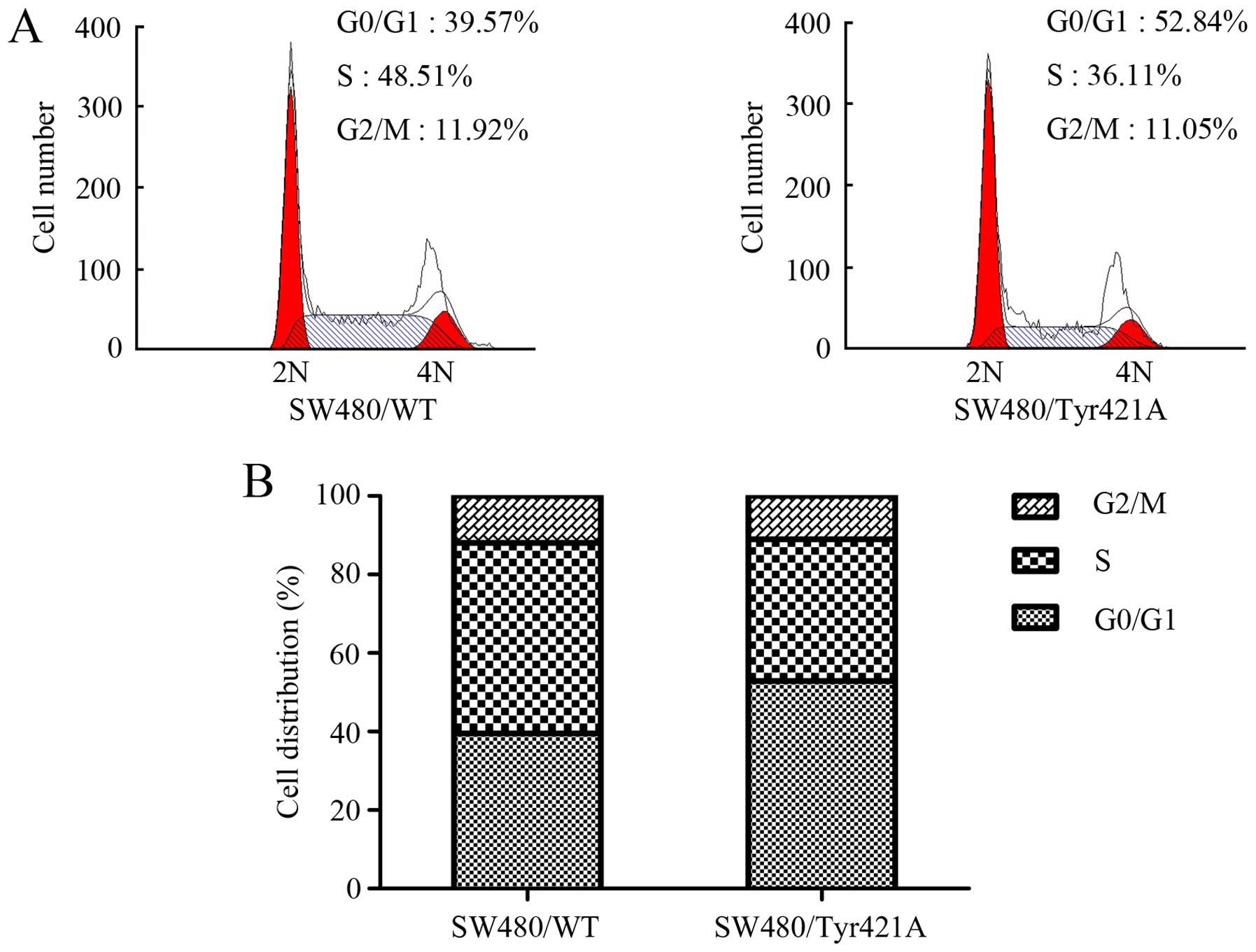|
1
|
Siegel RL, Miller KD and Jemal A: Cancer
statistics, 2016. CA Cancer J Clin. 66:7–30. 2016. View Article : Google Scholar : PubMed/NCBI
|
|
2
|
Cai JH, Zhao R, Zhu JW, Jin XL, Wan FJ,
Liu K, Ji XP, Zhu YB and Zhu ZG: Expression of cortactin correlates
with a poor prognosis in patients with stages II–III colorectal
adenocarcinoma. J Gastrointest Surg. 14:1248–1257. 2010. View Article : Google Scholar : PubMed/NCBI
|
|
3
|
van Rossum AG, Moolenaar WH and Schuuring
E: Cortactin affects cell migration by regulating intercellular
adhesion and cell spreading. Exp Cell Res. 312:1658–1670. 2006.
View Article : Google Scholar : PubMed/NCBI
|
|
4
|
Weaver AM: Cortactin in tumor
invasiveness. Cancer Lett. 265:157–166. 2008. View Article : Google Scholar : PubMed/NCBI
|
|
5
|
Rodrigo JP, García LA, Ramos S, Lazo PS
and Suárez C: EMS1 gene amplification correlates with poor
prognosis in squamous cell carcinomas of the head and neck. Clin
Cancer Res. 6:3177–3182. 2000.PubMed/NCBI
|
|
6
|
Lu P, Qiao J, He W, Wang J, Jia Y, Sun Y,
Tang S, Fu L and Qin Y: Genome-wide gene expression profile
analyses identify CTTN as a potential prognostic marker in
esophageal cancer. PLoS One. 9:e889182014. View Article : Google Scholar : PubMed/NCBI
|
|
7
|
Wang X, Cao W, Mo M, Wang W, Wu H and Wang
J: VEGF and cortactin expression are independent predictors of
tumor recurrence following curative resection of gastric cancer. J
Surg Oncol. 102:325–330. 2010. View Article : Google Scholar : PubMed/NCBI
|
|
8
|
Yuan BZ, Zhou X, Zimonjic DB, Durkin ME
and Popescu NC: Amplification and overexpression of the EMS 1
oncogene, a possible prognostic marker, in human hepatocellular
carcinoma. J Mol Diagn. 5:48–53. 2003. View Article : Google Scholar : PubMed/NCBI
|
|
9
|
Xu XZ, Garcia MV, Li TY, Khor LY,
Gajapathy RS, Spittle C, Weed S, Lessin SR and Wu H: Cytoskeleton
alterations in melanoma: Aberrant expression of cortactin, an
actin-binding adapter protein, correlates with melanocytic tumor
progression. Mod Pathol. 23:187–196. 2010. View Article : Google Scholar : PubMed/NCBI
|
|
10
|
Hirakawa H, Shibata K and Nakayama T:
Localization of cortactin is associated with colorectal cancer
development. Int J Oncol. 35:1271–1276. 2009. View Article : Google Scholar : PubMed/NCBI
|
|
11
|
Li A, Zhang L, Zhang X, Jin W and Ren Y:
Expression and clinical significance of cortactin protein in
ovarian neoplasms. Clin Transl Oncol. 18:220–227. 2016. View Article : Google Scholar : PubMed/NCBI
|
|
12
|
Wei J, Zhao ZX, Li Y, Zhou ZQ and You TG:
Cortactin expression confers a more malignant phenotype to gastric
cancer SGC-7901 cells. World J Gastroenterol. 20:3287–3300. 2014.
View Article : Google Scholar : PubMed/NCBI
|
|
13
|
Mezi S, Todi L, Orsi E, Angeloni A and
Mancini P: Involvement of the Src-cortactin pathway in migration
induced by IGF-1 and EGF in human breast cancer cells. Int J Oncol.
41:2128–2138. 2012.PubMed/NCBI
|
|
14
|
Martinez-Quiles N, Ho HY, Kirschner MW,
Ramesh N and Geha RS: Erk/Src phosphorylation of cortactin acts as
a switch on-switch off mechanism that controls its ability to
activate N-WASP. Mol Cell Biol. 24:5269–5280. 2004. View Article : Google Scholar : PubMed/NCBI
|
|
15
|
Head JA, Jiang D, Li M, Zorn LJ, Schaefer
EM, Parsons JT and Weed SA: Cortactin tyrosine phosphorylation
requires Rac1 activity and association with the cortical actin
cytoskeleton. Mol Biol Cell. 14:3216–3229. 2003. View Article : Google Scholar : PubMed/NCBI
|
|
16
|
Hanahan D and Weinberg RA: Hallmarks of
cancer: The next generation. Cell. 144:646–674. 2011. View Article : Google Scholar : PubMed/NCBI
|
|
17
|
Kanner SB, Reynolds AB, Vines RR and
Parsons JT: Monoclonal antibodies to individual
tyrosine-phosphorylated protein substrates of oncogene-encoded
tyrosine kinases. Proc Natl Acad Sci USA. 87:3328–3332. 1990.
View Article : Google Scholar : PubMed/NCBI
|
|
18
|
Schuuring E: The involvement of the
chromosome 11q13 region in human malignancies: Cyclin D1 and EMS1
are two new candidate oncogenes - a review. Gene. 159:83–96. 1995.
View Article : Google Scholar : PubMed/NCBI
|
|
19
|
Weed SA and Parsons JT: Cortactin:
Coupling membrane dynamics to cortical actin assembly. Oncogene.
20:6418–6434. 2001. View Article : Google Scholar : PubMed/NCBI
|
|
20
|
MacGrath SM and Koleske AJ: Cortactin in
cell migration and cancer at a glance. J Cell Sci. 125:1621–1626.
2012. View Article : Google Scholar : PubMed/NCBI
|
|
21
|
Li Y, Tondravi M, Liu J, Smith E,
Haudenschild CC, Kaczmarek M and Zhan X: Cortactin potentiates bone
metastasis of breast cancer cells. Cancer Res. 61:6906–6911.
2001.PubMed/NCBI
|
|
22
|
Ni QF, Yu JW, Qian F, Sun NZ, Xiao JJ and
Zhu JW: Cortactin promotes colon cancer progression by regulating
ERK pathway. Int J Oncol. 47:1034–1042. 2015.PubMed/NCBI
|
|
23
|
Boyle SN, Michaud GA, Schweitzer B, Predki
PF and Koleske AJ: A critical role for cortactin phosphorylation by
Abl-family kinases in PDGF-induced dorsal-wave formation. Curr
Biol. 17:445–451. 2007. View Article : Google Scholar : PubMed/NCBI
|
|
24
|
Radhakrishnan VM, Kojs P, Young G,
Ramalingam R, Jagadish B, Mash EA, Martinez JD, Ghishan FK and
Kiela PR: pTyr421 cortactin is overexpressed in colon
cancer and is dephosphorylated by curcumin: Involvement of
non-receptor type 1 protein tyrosine phosphatase (PTPN1). PLoS One.
9:e857962014. View Article : Google Scholar : PubMed/NCBI
|
|
25
|
Resnitzky D and Reed SI: Different roles
for cyclins D1 and E in regulation of the G1-to-S
transition. Mol Cell Biol. 15:3463–3469. 1995. View Article : Google Scholar : PubMed/NCBI
|
|
26
|
Li T, Song T, Ni L, Yang G, Song X, Wu L,
Liu B and Liu C: The p-ERK-p-c-Jun-cyclinD1 pathway is involved in
proliferation of smooth muscle cells after exposure to cigarette
smoke extract. Biochem Biophys Res Commun. 453:316–320. 2014.
View Article : Google Scholar : PubMed/NCBI
|















